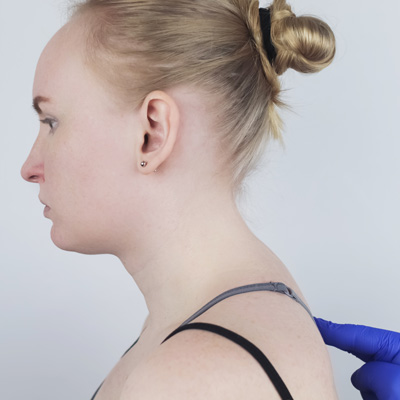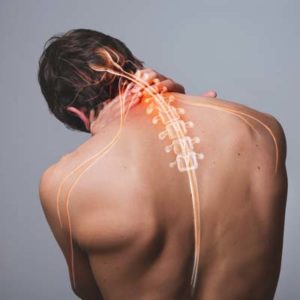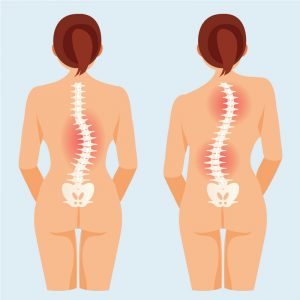Last Modified on July 31, 2025 by Dr. Tyler Meier

Have you noticed a visible hump at the base of your neck and found yourself searching online for “how to fix neck hump” solutions? You’re not alone. With the right approach, you can improve and even reverse this condition. Let’s explore what causes neck humps and how Chiropractic BioPhysics (CBP) offers a proven solution.
Understanding Neck Hump (aka Dowager’s Hump)
A neck hump, medically known as kyphosis or “dowager’s hump”, is that rounded bump that appears at the base of your neck. But here’s what many people don’t realize: not all neck humps are the same.
There are two main types we encounter in our practice.
- Structural type, caused by actual spinal misalignment and vertebral changes.
- Fat pad type, where excess tissue accumulates in the area due to hormonal changes or weight gain.
The anatomy behind the problem involves forward head posture and spinal misalignment. When your head moves forward from its natural position, it creates a cascade of postural changes. Your upper back rounds, your shoulders roll forward, and the C7 vertebra (the prominent bone at the base of your neck) becomes more visible.
Key signs include the obvious C7 prominence, head tilting forward, and that characteristic upper back rounding that makes clothes fit poorly and photographs feel embarrassing.
See more: The Benefits of Chiropractic Care for People with a Hunched Back
What Causes a Neck Hump?
Understanding the root causes helps us create effective treatment plans. The primary culprit in our modern world is forward head posture, largely driven by our screen-heavy lifestyles.
- Technology plays a massive role. The average person checks their phone 96 times per day, according to research by Asurion. Each time we look down at our devices, we’re putting up to 60 pounds of pressure on our cervical spine
- Muscle imbalances develop over time. The trapezius muscles in your upper back become chronically tight and overworked, while the rhomboids and middle trapezius weaken from disuse. This creates an imbalance that pulls your head forward and rounds your shoulders.
- Spinal degeneration accelerates the process. When vertebrae compress and discs lose height, the natural curves of your spine flatten or reverse. This is particularly common in the cervical and thoracic regions where neck humps develop.
- Osteoporosis compounds the problem, especially in postmenopausal women.
- Hormonal changes, particularly declining estrogen levels during perimenopause, affect both bone density and fat distribution..
- Poor lifestyle habits like sleeping on multiple pillows, prolonged sitting, and sedentary work environments maintain these problematic postures throughout the day and night.
Self-Assessment: Do You Have a Neck Hump?
Before we discuss treatment, let’s help you assess your current posture. The wall test is a simple but effective method we use in our clinic.
Here’s how to perform the wall test: Stand with your back against a wall, heels about 4 inches away from the baseboard. Let your shoulders and head rest naturally against the wall. If the back of your head doesn’t touch the wall, or if you have to tilt your chin up significantly to make contact, you likely have forward head posture.
Technology can help too. Apps like PostureScreen Mobile and devices like UPRIGHT Go provide objective measurements of your posture throughout the day. These tools offer valuable feedback about your alignment patterns.
Distinguishing between fat and structural issues requires professional assessment, but you can get clues at home. If the prominence is soft and squishy, it’s likely fat accumulation. If it’s firm and bony, you’re dealing with structural changes that need specific treatment approaches.
Can You Fix a Neck Hump Naturally? Yes – Here’s How
The answer is absolutely yes, but success depends on using the right methods consistently. This is where our expertise in Chiropractic BioPhysics makes all the difference.
Corrective Chiropractic Care: Why CBP Works
Chiropractic BioPhysics is the most researched chiropractic technique in the world, with over 200 peer-reviewed publications supporting its effectiveness. Unlike traditional chiropractic care that focuses primarily on pain relief, CBP targets the underlying structural problems causing your neck hump.
CBP is different because it’s evidence-based and measurable. We use precise X-ray analysis and postural measurements to create a customized treatment plan. Dr. Deed Harrison’s research, published in the Journal of Physical Therapy Science, demonstrates that CBP techniques can achieve significant postural improvements that traditional methods cannot.
Here’s how we approach treatment: We start with detailed posture X-rays and mirror image postural analysis. This allows us to see exactly how your spine deviates from normal and design specific corrective exercises and adjustments.
Long-term correction is our goal, not just temporary pain relief. While traditional chiropractic might provide short-term comfort, CBP creates lasting structural changes that prevent the problem from returning.
At-Home Exercises & Stretches
While professional care is essential for significant structural changes, specific exercises can support your progress and maintain improvements.
- Chin tucks are your best friend. This simple exercise helps retrain the deep neck flexors and counteract forward head posture. Perform 10 repetitions, holding each for 5 seconds, three times daily.
- Wall angels help open up rounded shoulders. Stand against a wall and slowly slide your arms up and down like making a snow angel. This stretches tight chest muscles while strengthening your upper back.
- Thoracic foam rolling addresses the rounded upper back that contributes to neck hump appearance. Spend 2-3 minutes daily rolling the middle of your back to improve mobility.
- Sternocleidomastoid (SCM) and trapezius stretches target the specific muscles that become tight with forward head posture. We provide detailed instructions and downloadable exercise charts to all our patients.
Strengthen to Reverse the Hump
Stretching alone isn’t enough. Why does strengthening works better? When you only stretch tight muscles without strengthening the weak ones, the imbalance persists. Strengthening creates the muscular foundation needed to maintain proper alignment.
- Upper back strengthening exercises like rows and resistance band pulls target the weakened posterior chain muscles. These exercises help pull your head back into proper alignment.
- Core stabilization work through planks and bird-dog exercises creates a strong foundation for good posture. A stable core reduces the compensatory stress placed on your neck and upper back.
Daily Habits & Ergonomics Matter
Your environment shapes your posture more than you might realize. Small changes in your daily setup can have profound effects on your neck hump progression.
Desk setup is crucial. Your monitor should be at eye level, keyboard at elbow height, and your chair should support your lower back’s natural curve. We provide detailed ergonomic checklists to all our patients.
Sleep posture affects your progress. The wrong pillow can maintain forward head posture for 6-8 hours every night. We recommend pillows that support your neck’s natural curve while keeping your head in neutral alignment.
Mindful movement throughout the day helps break up prolonged static postures. Set reminders every 30 minutes to check your posture and perform a quick chin tuck.
Addressing Hormonal & Weight Factors
For many of our patients, especially women over 40, hormonal changes play a significant role in neck hump development.
Estrogen decline affects collagen production and bone density, while elevated cortisol from chronic stress promotes fat accumulation in the upper back and neck area. Dr. Pamela Peeke’s research shows this “toxic weight” pattern is particularly stubborn but responds well to targeted interventions.
Nutrition supports both posture and bone health. We recommend adequate protein for muscle maintenance, calcium and vitamin D for bone health, and anti-inflammatory foods to reduce tissue inflammation.
Stress management is essential because chronic cortisol elevation promotes both postural breakdown and fat accumulation in problem areas. Regular exercise, meditation, and adequate sleep help normalize hormone levels.
Chiropractic Myths About Fixing a Neck Hump
Let’s address some common misconceptions we encounter in our practice.
“You can just stretch it out” – This isn’t always true. While stretching helps with muscle tightness, structural changes require specific corrective techniques and strengthening exercises.
“Only surgery works” – This is completely false. Research published in the European Spine Journal shows that conservative treatment, including chiropractic care, effectively improves postural kyphosis in most cases.
“Chiropractors just crack backs” – This outdated view doesn’t reflect modern chiropractic, especially CBP. We use precise, gentle techniques combined with specific exercises and postural retraining.
Is It Too Late to Fix a Neck Hump?
We get this question frequently, especially from patients over 50 who feel they’ve waited too long to address their posture.
Several factors affect reversibility: your age, the severity of structural changes, and your commitment to the treatment process all play roles.
We’ve seen encouraging results even in patients with advanced postural changes. While complete reversal may not always be possible, significant improvement in both appearance and function is achievable.
It’s never too late to improve your posture and confidence. Even modest improvements can have profound effects on how you look and feel.
How to Prevent Neck Hump from Coming Back
Prevention is always easier than treatment. Once we’ve helped improve your posture, maintaining those gains requires ongoing attention.
Daily “posture reset” routines take just 5-10 minutes but help maintain the improvements you’ve worked hard to achieve. We teach all our patients these simple but effective techniques.
Quarterly check-ins with your CBP chiropractor help catch small problems before they become big ones. Think of it as maintenance for your spine.
Home posture monitoring using mirror checks or phone photos helps you stay aware of your alignment throughout the day.
Helpful tools like wearable posture trainers and ergonomic supports can provide ongoing feedback and support for good posture habits.
Conclusion: Straighten Up – For Life
With proper understanding of the causes, commitment to evidence-based treatment like CBP, and consistent daily habits, you can achieve meaningful improvements in both your posture and confidence.
The key is addressing the root structural problems, not just the surface symptoms. This requires a comprehensive approach that combines professional chiropractic care with supportive exercises and lifestyle modifications.
If you’re ready to take control of your posture and eliminate that troublesome neck hump, we’re here to help. At CorePosture Chiropractic in Newport Beach, we’ve helped hundreds of patients achieve lasting postural improvements through our specialized CBP approach.
Ready to get started? Book a free consultation with our team today. Let’s work together to help you stand tall and feel confident again.

Dr. Tyler Meier is a board-certified, licensed chiropractor and founder of CorePosture Chiropractic in Newport Beach, CA







